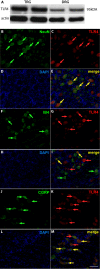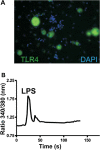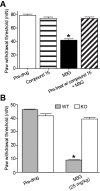Neuroexcitatory effects of morphine-3-glucuronide are dependent on Toll-like receptor 4 signaling
- PMID: 22898544
- PMCID: PMC3519737
- DOI: 10.1186/1742-2094-9-200
Neuroexcitatory effects of morphine-3-glucuronide are dependent on Toll-like receptor 4 signaling
Abstract
Background: Multiple adverse events are associated with the use of morphine for the treatment of chronic non-cancer pain, including opioid-induced hyperalgesia (OIH). Mechanisms of OIH are independent of opioid tolerance and may involve the morphine metabolite morphine-3-glucuronide (M3G). M3G exhibits limited affinity for opioid receptors and no analgesic effect. Previous reports suggest that M3G can act via the Toll-like receptor 4 (TLR4)/myeloid differentiation protein-2 (MD-2) heterodimer in the central nervous system to elicit pain.
Methods: Immunoblot and immunocytochemistry methods were used to characterize the protein expression of TLR4 present in lumbar dorsal root ganglion (DRG). Using in vitro intracellular calcium and current clamp techniques, we determined whether TLR4 activation as elicited by the prototypical agonists of TLR4, lipopolysaccharide (LPS) and M3G, contributed to changes in intracellular calcium and increased excitation. Rodents were also injected with M3G to determine the degree to which M3G-induced tactile hyperalgesia could be diminished using either a small molecule inhibitor of the MD-2/TLR4 complex in rats or TLR4 knockout mice. Whole cell voltage-clamp recordings were made from small- and medium-diameter DRG neurons (25 μm < DRG diameter <45 μm) for both control and M3G-treated neurons to determine the potential influence on voltage-gated sodium channels (NaVs).
Results: We observed that TLR4 immunoreactivity was present in peptidergic and non-peptidergic sensory neurons in the DRG. Non-neuronal cells in the DRG lacked evidence of TLR4 expression. Approximately 15% of assayed small- and medium-diameter sensory neurons exhibited a change in intracellular calcium following LPS administration. Both nociceptive and non-nociceptive neurons were observed to respond, and approximately 40% of these cells were capsaicin-insensitive. Increased excitability observed in sensory neurons following LPS or M3G could be eliminated using Compound 15, a small molecule inhibitor of the TLR4/MD-2 complex. Likewise, systemic injection of M3G induced rapid tactile, but not thermal, nociceptive behavioral changes in the rat, which were prevented by pre-treating animals with Compound 15. Unlike TLR4 wild-type mice, TLR4 knockout mice did not exhibit M3G-induced hyperalgesia. As abnormal pain sensitivity is often associated with NaVs, we predicted that M3G acting via the MD-2/TLR4 complex may affect the density and gating of NaVs in sensory neurons. We show that M3G increases tetrodotoxin-sensitive and tetrodotoxin-resistant (NaV1.9) current densities.
Conclusions: These outcomes provide evidence that M3G may play a role in OIH via the TLR4/MD-2 heterodimer complex and biophysical properties of tetrodotoxin-sensitive and tetrodotoxin-resistant NaV currents.
Figures





Similar articles
-
Carbamazepine potentiates the effectiveness of morphine in a rodent model of neuropathic pain.PLoS One. 2014 Sep 15;9(9):e107399. doi: 10.1371/journal.pone.0107399. eCollection 2014. PLoS One. 2014. PMID: 25221944 Free PMC article.
-
Endothelin A receptor in nociceptors is essential for persistent mechanical pain in a chronic pancreatitis of mouse model.World J Gastroenterol. 2025 Jun 21;31(23):103848. doi: 10.3748/wjg.v31.i23.103848. World J Gastroenterol. 2025. PMID: 40575333 Free PMC article.
-
Nociceptive transient receptor potential ankyrin 1 (TRPA1) in sensory neurons are targets of the antifungal drug econazole.BMC Pharmacol Toxicol. 2024 Aug 21;25(1):53. doi: 10.1186/s40360-024-00779-x. BMC Pharmacol Toxicol. 2024. PMID: 39169383 Free PMC article.
-
Oxycodone for cancer-related pain.Cochrane Database Syst Rev. 2022 Jun 9;6(6):CD003870. doi: 10.1002/14651858.CD003870.pub7. Cochrane Database Syst Rev. 2022. PMID: 35679121 Free PMC article.
-
Oral morphine for cancer pain.Cochrane Database Syst Rev. 2016 Apr 22;4(4):CD003868. doi: 10.1002/14651858.CD003868.pub4. Cochrane Database Syst Rev. 2016. PMID: 27105021 Free PMC article.
Cited by
-
Damage-associated molecular patterns generated in osteoarthritis directly excite murine nociceptive neurons through Toll-like receptor 4.Arthritis Rheumatol. 2015 Nov;67(11):2933-43. doi: 10.1002/art.39291. Arthritis Rheumatol. 2015. PMID: 26245312 Free PMC article.
-
Lipopolysaccharide and Morphine-3-Glucuronide-Induced Immune Signalling Increases the Expression of Polysialic Acid in PC12 Cells.Mol Neurobiol. 2020 Feb;57(2):964-975. doi: 10.1007/s12035-019-01791-7. Epub 2019 Oct 24. Mol Neurobiol. 2020. PMID: 31646464
-
Morphine-3-Glucuronide, Physiology and Behavior.Front Mol Neurosci. 2022 May 12;15:882443. doi: 10.3389/fnmol.2022.882443. eCollection 2022. Front Mol Neurosci. 2022. PMID: 35645730 Free PMC article. Review.
-
TLR4 Antagonism Reduces Movement-Induced Nociception and ATF-3 Expression in Experimental Osteoarthritis.J Pain Res. 2021 Aug 24;14:2615-2627. doi: 10.2147/JPR.S317877. eCollection 2021. J Pain Res. 2021. PMID: 34466029 Free PMC article.
-
δ-opioid Receptor, Microglia and Neuroinflammation.Aging Dis. 2023 Jun 1;14(3):778-793. doi: 10.14336/AD.2022.0912. Aging Dis. 2023. PMID: 37191426 Free PMC article. Review.
References
-
- Zelcer N, van de Wetering K, Hillebrand M, Sarton E, Kuil A, Wielinga PR, Tephly T, Dahan A, Beijnen JH, Borst P. Mice lacking multidrug resistance protein 3 show altered morphine pharmacokinetics and morphine-6-glucuronide antinociception. Proc Natl Acad Sci U S A. 2005;102:7274–7279. doi: 10.1073/pnas.0502530102. - DOI - PMC - PubMed
Publication types
MeSH terms
Substances
Grants and funding
LinkOut - more resources
Full Text Sources
Medical
Research Materials

